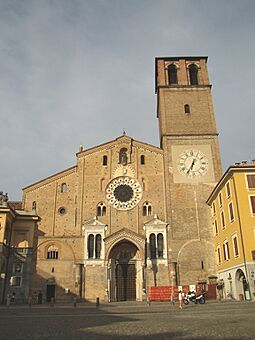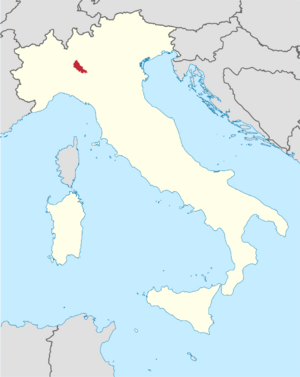Roman Catholic Diocese of Lodi facts for kids
Quick facts for kids Diocese of LodiDioecesis Laudensis |
|
|---|---|

Lodi Cathedral
|
|
| Location | |
| Country | Italy |
| Ecclesiastical province | Milan |
| Statistics | |
| Area | 894 km2 (345 sq mi) |
| Population - Total - Catholics |
(as of 2021) 285,510 271,689 (95.2%) |
| Parishes | 123 |
| Information | |
| Denomination | Catholic Church |
| Rite | Roman Rite |
| Established | 4th century |
| Cathedral | Basilica Cattedrale di Santa Maria Assunta |
| Secular priests | 158 (diocesan) 11 (Religious Orders) 4 Permanent Deacons |
| Current leadership | |
| Pope | Francis |
| Bishop | Maurizio Malvestiti |
| Vicar General | Bassiano Uggè |
| Emeritus Bishops | Giuseppe Merisi |
| Map | |
 |
|
| Website | |
| www.diocesi.lodi.it | |
The Diocese of Lodi (called Dioecesis Laudensis in Latin) is a special area of the Catholic Church led by a bishop. It's part of the Latin Church, which is the largest group within the Catholic Church. This diocese has been around for a very long time, since the 4th century! It works closely with the Archdiocese of Milan.
Contents
History of the Diocese of Lodi
The exact start of the Diocese of Lodi is a bit unclear. Some people believe St. Bassianus was the first bishop. He is the patron saint of Lodi and was definitely a bishop there by the year 378.
Lodi faced many challenges over the centuries. In May 1191, the city was captured by forces from Milan. Later, in 1252, Pope Innocent IV officially brought the Diocese of Lodi back after it had been stopped for a while by Pope Gregory IX.
In 1298, Bishop Berardus Talente became the first bishop of Lodi to also be called a Count. This showed how important the bishop was in the region. The main building for the bishop, called the episcopal palace, was built in the 1730s.
What are Synods?
A synod is an important meeting where the bishop of a diocese gathers with his clergy (priests and deacons). These meetings happen from time to time. Their main goals are to share new rules from the bishop, discuss and agree on important decisions, and announce new laws from the diocese, the larger church area (province), or the Pope.
Important Synods in Lodi
Many bishops of Lodi have held synods over the years to guide their diocese. For example, Bishop Paolo Cadamosto held a synod in 1364 to help protect the church's laws. Later, in 1591, Bishop Ludovico Taverna led another important synod.
More recently, in January 2020, the fourteenth diocesan synod took place. This meeting focused on spreading the Christian message, following ideas from Pope Francis. Bishop Maurizio Malvestiti led this important event.
The Cathedral and its Chapter
After the city of Lodi was destroyed in 1111, a new main church, called a cathedral, started being built on August 3, 1158. This new cathedral was mostly finished by 1163. The remains of Bishop Bassianus were reburied there. The cathedral was first dedicated to St. Bassianus, but later it was dedicated to the Assumption of the Virgin Mary.
The cathedral has a group of priests called a Chapter. In 1617, this Chapter had five main leaders and nineteen Canons (priests who serve the cathedral). By 1817, the Chapter was smaller, with one main leader and eight Canons.
Bishops of Lodi
The Diocese of Lodi has had many bishops throughout its long history. Here are some of the notable ones:
Early Bishops (to 1200)
- Julian (date unknown)
- Bassianus (378-413)
- Cyriacus (attested 451)
- Ticianus (474–476)
- Projectus (attested 575 or 578)
- Donatus (attested 679)
- Hippolytus (attested 759)
- Erimpertus (attested 827)
- Jacobus (attested 852)
- Gerardus (attested 883, 887–888)
- Amaione (attested 892)
- Eldegarius (attested 903, 915)
- Zilicus (attested 924)?
- Olgerius (attested 935?)
- Ambrosius (attested 942)
- Aldegrausus (attested 951–970)
- Andreas (970–1002)
- Notker (11th century)
- Olderico (1027)
- Ambrogio Arluno (attested 1037–1051)
- Opizo (attested 1059– ? )
- Fredentio (11th cent.)
- Rainerius (attested 1092)
- Ardericus de Vignate (attested 1117–1127)
- Alberico di Merlino (1158–1168)
- Alberto Quadrelli (1168–1173)
- Albericus dal Corno (1173–1189)
- Ardericus di Sant'Agnese (1189–1217)
Bishops from 1200 to 1500
- Ardericus (d. 1217)
- Jacobus de Cereto, O. Cist. (1217)
- Ambrosius del Corno (1218)
- Ottobellus Soffientino (attested 1219, 1243)
- Bonusjoannes Fissiraga (1252–1289)
- Raimundus Sommaripa, O.P. (1289–1296)
- Berardus Talente (1296–1307)
- Aegidius dall' Aqua (1307–1312)
- Leone Palatini, O.Min. (1318–1343)
- Lucas da Castello, O.Min. (1343–1353)
- Paolo Cadamosto (1354–1387)
- Pietro della Scala (1388–1392)
- Bonifazio Buttigella, O.E.S.A. (1393–1404)
- Giacomo Balardi Arrigoni, O.P. (1407–1418)
- Gerardo Landriani (1419–1437)
- Antonio Bernieri (1435–1456)
- Carlo Pallavicino (1456–1497)
- Ottaviano Maria Sforza (1st time) (1497–1499 Resigned)
Bishops from 1500 to 1800
- Claude de Seyssel Administrator (1501 – 1512)
- Ottaviano Maria Sforza (2nd time) (1512–1519) Administrator
- Gerolamo Sansoni (1519 – 1536)
- Cardinal Giacomo Simonetta (1536 – 1537)
- Giovanni Simonetta (1537–1557)
- Gianantonio Capizucchi (1557 – 1569)
- Antonio Scarampi (1569–1576)
- Gerolamo Federici (1576–1579)
- Ludovico Taverna (1579–1616)
- Michelangelo Seghizzi, O.P. (1616–1625)
- Clemente Gera (1625–1643)
- Pietro Vidoni (Sr.) (1644–1669 Resigned)
- Serafino Corio, C.R. (1669–1671)
- Giovanni Battista Rabbia, C.R. (1671–1672)
- Bartolomeo Menatti (1673 – 1702)
- Ortensio Visconti (1702 – 1725)
- Carlo Ambrogio Mezzabarba (1725 –1741)
- Giuseppe Gallarati (1742 – 1765 Resigned)
- Salvatore Andriani, B. (1765 – 1784)
- Gianantonio Della Beretta (1785 – 1816)
Bishops since 1819
- Alessandro Maria Pagani (1819–1835)
- Gaetano Benaglia (1837–1868)
- Domenico Maria Gelmini (1871 – 1888)
- Giovanni Battista Rota (1888 – 1913)
- Pietro Zanolini (1913 – 1923)
- Ludovico Antomelli, O.F.M. (1924 – 1927)
- Pietro Calchi Novati (1927 – 1952)
- Tarcisio Vincenzo Benedetti, O.C.D. (1952 – 1972)
- Giulio Oggioni (1972 –1977)
- Paolo Magnani (1977 –1988)
- Giacomo Capuzzi (1989 – 2005)
- Giuseppe Merisi (2005 – 2014 Retired)
- Maurizio Malvestiti (2014 – Present)
Parishes
The Diocese of Lodi has changed how it is organized inside. It now has 123 parishes, which are local church communities.

